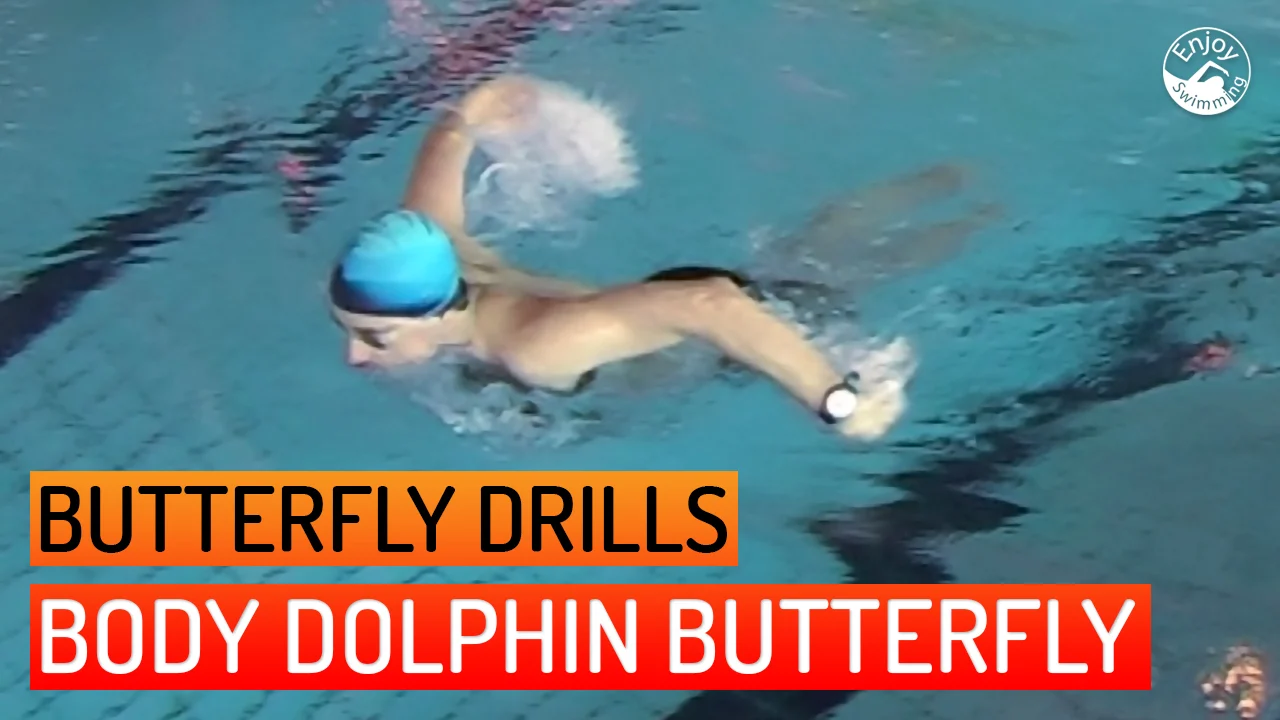Body-Dolphin Butterfly is one of our swimming drills for the butterfly stroke. It allows you to practice butterfly in a relaxed fashion.
Body-Dolphin Butterfly follows Hip-Delay Butterfly and precedes Easy Butterfly in our series of swimming drills for the butterfly.

In Body-Dolphin Butterfly, you take one full stroke of butterfly, followed by one or several Hand-Lead Body Dolphins, before taking the next stroke of butterfly, and so on.
Alternating tiring full-stroke cycles and more relaxed body dolphin cycles allows you to practice the movements of the butterfly stroke without getting tired so quickly. Consequently, you can stay focused on your swimming technique for longer.
Video Demonstration
The following video illustrates the Body-Dolphin Butterfly drill:
Swimming Drill Instructions
Here is how to practice Body-Dolphin Butterfly:
- Push off from the wall in a prone position with your arms stretched out in front of you and your hands close together.
- Your head should be in line with your torso with your face looking down.
- Perform two hand-lead body dolphins.
- Follow up with one full-stroke cycle of butterfly:
- Slide your arms to the corners.
- Sweep your hands toward your chest and then toward your hips, as you practiced in the Stoneskipper drill.
- When your hands get close to the hips, sweep them out sideways and upward and start the arm recovery, as you practiced in Hip-Delay Butterfly.
- Land your arms, head, and chest forward in the water.
- Begin a new drill cycle of two body undulations and one stroke, and continue this sequence of movements for the rest of the length.
Breathing
You breathe in while performing the underwater portion of the arm stroke as you lift your chest and shoulders above the water surface.
Keep your head low and look down and slightly forward while breathing.
After taking a breath, exhale continuously in the water until you perform the next stroke of butterfly.
Additional Tips
Even though you can now perform the possibly tiring butterfly strokes, the body dolphins you add between strokes should allow you to relax your upper body muscles.
Focus on being relaxed and keeping the rhythm of your body undulations while performing the arm stroke and breathing.
Experiment with the number of body undulations between each butterfly stroke. Adding more undulations decreases the number of strokes you take for each lap, but it also limits the number of breaths you take and hence, the oxygen at your disposal.
On the other hand, while reducing the number of undulations between each stroke is more tiring, it also provides you with more oxygen.
Remember to stay close to the water surface to save energy, both while performing the butterfly strokes as well as the body dolphins.
Learning Path for the Butterfly Stroke
Below is an overview of our series of articles on learning the butterfly stroke. Each article in this series contains one or more drills that have to be mastered. The current article is highlighted:
Once you have gone through all the steps of this learning path, you should be able to swim butterfly without any problems.
Good luck!

Tyrone
Thursday 13th of September 2018
I was wondering where I could download this video so I could review it, maybe you could send it to my email? Also, thanks a lot, this is amazing work
Christophe
Thursday 13th of September 2018
Hi Tyrone,
I'm sorry, the video platform I use doesn't allow for downloads. This protects me against copycat sites that would use videos without my permission.